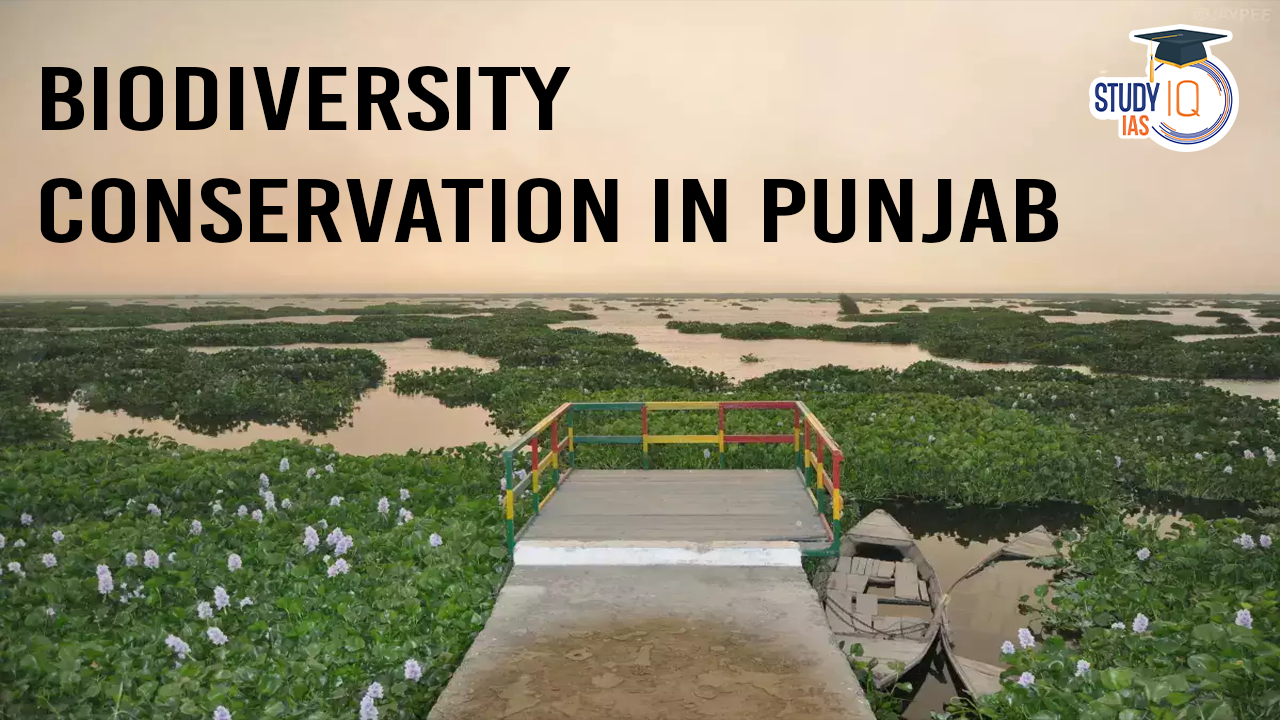Table of Contents
Biodiversity Conservation in Punjab
There are two approaches to biodiversity conservation: In-situ Conservation and Ex-situ Conservation.
In-Situ Conservation
In-situ conservation refers to the protection and management of species and ecosystems within their natural habitats. It involves various techniques such as:
- Designation of Protected Areas such as national parks, wildlife sanctuaries, and biosphere reserves.
- Efforts for Restoration of habitats such as reforestation, wetland restoration etc.
- Conservation initiatives for species like establishment of tiger and elephant reserves.
Ex-Situ Conservation
Ex-Situ Conservation is the conservation of biodiversity outside its natural habitat. This method is used when in-situ conservation is not feasible or requires additional support. It involves various techniques such as:
- Seed Banks for collection and storage of seeds
- Gene Banks for preservation of genetic material of plants, animals, and microorganisms.
- Captive Breeding Programs
- Botanical Gardens and Arboreta for cultivating and display diverse plant species
- Zoos and Aquariums for housing and caring for various animal species
Note: There are no national parks in Punjab.
Wildlife Sanctuaries
Wildlife Sanctuary is an area (other than an area comprised of any reserve forest or territorial waters) having adequate ecological, faunal, floral, natural, geomorphological or zoological significance. They are declared to protect, propagate or develop wildlife or its environment. The state government declares an area as a wildlife sanctuary under Section 26A of the Wildlife Protection Act, 1972.
Characteristics
- Human activities like harvesting of timber, collecting minor forest products and private ownership rights are allowed as long as they do not interfere with the well-being of animals.
- Wildlife Sanctuary can be created for a particular species. For example, Thane Creek Flamingo Sanctuary in Maharashtra
- It can be upgraded to a National Park. E.g., in 2020, the Assam government upgraded the Dehing Patkai Wildlife Sanctuary to a National Park.
- During settlement of claims, before finally notifying the Sanctuary, the Collector can allow the continuation of any right of any person in or over any land within the limits of the Sanctuary.
The Wildlife Wing is responsible for the protection, conservation and management of wildlife both in nature as well as in captivity. The protection works include the detection of wildlife offences and their prosecution in the courts and enforcement of the Wildlife (Protection) Act, 1972. The wildlife conservation and management activities involve the rehabilitation of various species of wildlife to their natural habitat, management of Zoos and Mini Zoos (Deer Parks), protection of rare and threatened species of birds and animals along with management and development of protected areas in the state. The wing has also designated official state symbols, as detailed below:
| Symbol | Name | Scientific Name |
| Tree | Shisham | Dalbergia sissoo |
| Animal | Black Buck | Antelope cervicapra L. |
| Bird | Baaz | Accipiter gentilis |
Additionally, the Forest Training School in Hoshiarpur organizes various training programs for frontline staff from the forest and wildlife departments.
Wildlife Sanctuaries in Punjab

| Wildlife Sanctuary | Location | Area (sq km) | Wildlife |
| Bir Aishwan Wildlife Sanctuary | 3 km from Sangrur city on Sohian road | 2.64 | Jungle cat, blue bull, hare, jackal, peafowl, black and grey partridges, rose-ringed parakeets, spotted owlet |
| Bir Bhadson Wildlife Sanctuary | Patiala | 10.23 | Blue bull, hare, jungle cat, jackal, rhesus macaque, peafowl, black and grey partridges, rose-ringed parakeets, spotted owlet |
| Bir Bhunerheri Wildlife Sanctuary | 15 km from Patiala on Patiala-Devigarh Road | 6.62 | Hog deer, blue bull, porcupine, black buck, sambar, jungle cat, jackal, rhesus monkey, peafowl |
| Bir Dosanjh Wildlife Sanctuary | Adjacent to Nabha town on Nabha-Jorepul road | 5.18 | Blue bull, jungle cat, jackal, rose-ringed parakeet, peafowl, black and grey partridges |
| Bir Mehas Wildlife Sanctuary | Village Mehas, adjacent to Nabha town on Nabha-Malerkotla road | 1.23 | Rhesus monkey, jungle cat, jackal, peacock, blue bull |
| Bir Moti Bagh Wildlife Sanctuary | 5 km from Patiala on Patiala-Dakala Road | 6.54 | Black buck, chital, hog deer, blue bull, wild boar, jackal, rhesus monkeys, peafowl, brahminy myna, black and grey partridges, quails |
| Abohar Wildlife Sanctuary | Firozpur district | 186.5 | Black buck, blue bull, wild boar |
| Bir Gurdialpura Wildlife Sanctuary | 45 km from Patiala city on Patiala-Samana-Shatrana road | 6.20 | Blue bull, hog deer, hare, jungle cat, jackal, rhesus monkeys, peafowl, black and grey partridges, dove, spotted owl |
| Harike Wildlife Sanctuary | Confluence of Beas and Sutlej rivers | 86 | Diverse wildlife, a major attraction for bird watching |
| Takhni-Rehmapur Wildlife Sanctuary | Hoshiarpur near village Mehngrowal | 3.82 | Sambar, hog deer, barking deer, jungle cat, jackal, leopard, wild boar, pangolin, various bird species |
| Jhajjar Bacholi Wildlife Sanctuary | Near Anandpur Sahib town in Rupnagar district | 1.16 | Sambar, barking deer, hare, jackal, leopard, python, cobra, rattlesnake |
| Kathlaur-Kushlian Wildlife Sanctuary | On the Amritsar-Jammu Highway bypass in the Pathankot district | 7.58 | Diverse habitat with forests, grasslands, and water bodies |
| Nangal Wildlife Sanctuary | Rupnagar district | 2.90 | Hog deer, Indian pangolin, python, sambar, black myna, coot, Indian grey hornbill |
Community Reserves
Conservation Reserves and Community Reserves were first introduced in the Wildlife (Protection) Amendment Act of 2002. These categories were added because of reduced protection in and around existing or proposed protected areas due to private ownership of land, and land use.
Conservation Reserves
The State Government can declare certain areas, especially those near national parks or sanctuaries, and those connecting protected areas, as conservation reserves under the Wildlife (Protection) Act, 1972 (Amendment 2002). This is done in consultation with local communities to safeguard landscapes, seascapes, plants, animals, and their habitats.
Characteristics
- Areas are designated as conservation reserves if they are uninhabited completely owned by the Government of India and used for subsistence by communities.
- Management of a Conservation Reserve is done as per provisions of section 36B of the Wildlife (Protection) Act, 1972 (Amendment 2002).
- The State Government shall constitute a conservation reserve management committee to advise the Chief Wildlife Warden to conserve, manage and maintain the conservation reserve.
Community Reserves
These are privately owned protected areas that serve as buffer zones or connectors between existing national parks, wildlife sanctuaries, and reserved forests in India. The State Government establishes a Community Reserve Management Committee to oversee the conservation, maintenance, and management of the community reserve. The committee will comprise five representatives nominated by the Village Panchayat and one representative from the State Forests or Wildlife Department under whose jurisdiction the community reserve is located.
Community and Conservation Reserves of Punjab (2024)
| Type | Name | Location |
| Community Reserves | Lalwan | District Hoshiarpur |
| Keshopur-Chammb | District Gurdaspur | |
| Siswan | District SAS Nagar | |
| Panniwala-Gumjal-Haripura-Diwankhera | District Fazilka | |
| Conservation Reserves | Rakh Sarai Amanat Khan | District Tarn Taran |
| Ropar Wetland (185 Km) | District Ropar | |
| Beas River | Area of River Beas | |
| Ranjit Sagar Dam | District Gurdaspur | |
| Kali Bein | District Kapurthala |
Biodiversity Heritage Sites
These are areas that are unique, ecologically fragile ecosystems having rich biodiversity. Under the Biological Diversity Act, 2002, the State Government in consultation with local bodies may notify areas of biodiversity importance as BHS. The State Government in consultation with the Central Government also frame rules for the management and conservation of BHS. As of September 2024, there are 9 BHS in Punjab.
Criteria for Declaration
- Contains a mix of natural, semi-natural, and man-made habitats with high biodiversity.
- Includes significant domesticated biodiversity or representative agro-ecosystems.
- Important for biodiversity and cultural heritage, such as sacred groves and community-conserved sites.
- Serves as refuges or corridors for threatened and endemic species, including urban greens and wetlands.
- Provides seasonal habitats for migrant species for feeding and breeding.
- Maintained as preservation plots by the Forest Department’s research division.
- Medicinal Plant Conservation Areas.
| Location/Area | Details |
| Inami Baag, Village Bassi Umar Khan, District Hoshiarpur | Known for elite mango varieties |
| Sacred Grove at Village Tibba Tapprian, District Rupnagar | Sacred grove |
| Sacred Grove at Village Kartoli, District Hoshiarpur | Sacred grove |
| Bir Sikhan Wala, Village Sikhan Wala, District Faridkot | Conserved area |
| Dhakki Sahib, District Ludhiana | Conserved area |
| Tilla Bhagat, Village Bhatti Wala, District Shri Muktsar Sahib | Conserved area |
| Chatpat-Bani, Village Kataru Chak, District Pathankot | Community-conserved sacred grove |
| Sant Sar, Village Khokhar & Harike, District Shri Muktsar Sahib | Conserved area |
| Areas outside Harike Wildlife Sanctuary, from Village Gagrewal to Goindwal Sahib on river Beas | Conservation of Indus River dolphins |
Zoological Parks
Zoos are facilities where animals are kept for public display, wildlife conservation, education, and research. These facilities help conserve wildlife through captive breeding programs, rescue and rehabilitation of injured or orphaned animals and promoting public support for wildlife conservation.
| Zoological Park | Details |
| Bir Moti Zoological Park | Situated 5 km from Patiala city on Patiala-Dakala Road. Established in 1968-69. Area: 8.00 hectares. |
| Bir Talab Zoological Park | Approximately 5 km from Bathinda city. Established in 1977-78. Area: 20.00 hectares. Livestock: |
| Mahendra Chaudhary Zoological Park | Located in Mohali. Established in 1977. Area: 202.00 hectares. Known as Chatt Bir Zoo, featuring a lion safari. 82 species of reptiles, animals, and birds. |
| Neelon Zoological Park | Located on the banks of Sirhind Canal, 5 km from Samrala town and 20 km from Ludhiana city. Area: Approximately 4.00 hectares. |
| Tiger Safari Zoological Park | Situated in Ludhiana. Spread over an area of 8 hectares. |
Botanical Gardens
Botanical gardens in India are regulated and managed by various governmental and non-governmental organizations including universities, research institutes, and local municipal bodies. There are more than 120 botanical gardens in India. Some botanical gardens come under direct control of the Botanical Survey of India.
| Botanical Garden | Location |
| Baradari Garden | Patiala |
| Aam Khas Bagh | Sirhind, Fatehgarh Sahib |
| Kaima Botanic Garden | Kapurthala |
| Shalimar Botanical Garden | Kapurthala |
| Ram Bagh Botanical Garden | Amritsar |
Wetland Conservation
Wetlands are areas where water covers the soil or is present either at or near the surface of the soil all year or for varying periods of time during the year. They encompass various types of areas such as marshes, fens, peatlands, and bodies of water, whether natural or man-made, that can be permanent or temporary, with water that can be stagnant or flowing.
Punjab is home to 21 wetlands, comprising 12 natural inland wetlands and 9 man-made ones, covering 8.39 sq. km and 147.39 sq. km, respectively. These wetlands serve as vital habitats for a wide range of flora and fauna, including rare and globally endangered bird species. They have become excellent waterfowl habitats, with the Harike wetland recognized as an Important Bird Area (IBA) by the Bombay Natural History Society.

Harike and Nangal wetlands have also been designated as Wildlife Sanctuaries under the Wildlife (Protection) Act, 1972. However, changes in land-use patterns within wetland catchments and increasing environmental pressures have significantly affected bird populations visiting these areas. The habitats have suffered due to pollution, drainage, disruption of natural water flow, farming activities, and other human-induced disturbances.
Ramsar Convention
It is an international treaty that was signed in 1971 in the Ramsar city of Iran and came into force in 1975. It aims to promote the conservation and sustainable use of wetlands. It has been ratified by 170 countries (including India), making it one of the most successful international environmental treaties.
Ramsar Sites: It is a wetland site designated to be of international importance. These wetlands are protected under strict guidelines of the Ramsar Convention on Wetlands.
- Any wetland to be declared a wetland of international importance should support vulnerable
- endangered or threatened species and attract more than 20,000 or more water birds.
- The declaration would provide an opportunity to seek international technical support for conservation and sustainable use of wetlands through participatory mechanisms.
- It would also ensure international cooperation and financial assistance for wetland conservation.
Ramsar Sites in Punjab
| Ramsar Site | Areas | Description |
| Harike Wetland | Ferozepur, Kapurthala, Tarn Taran |
|
| Kanjli Wetland | Kapurthala |
|
| Ropar Wetland | Ropar |
|
| Nangal Wildlife Sanctuary | Anandpur Sahib, Ropar Distt. |
|
| Beas Conservation Reserve | 185 km stretch of Beas River in Tarn Taran, Hoshiarpur and Kapurthala Districts. |
|
| Keshopur-Miani Community Reserve | Gurdaspur |
|
Other Wetlands in Punjab
| Wetland | Type | Location |
| Ranjit Sagar Wetland
-National Wetland |
Manmade | Gurdaspur |
| Jastarwal Wetland
-State Wetland |
Natural | Amritsar |
| Kahnuwan Chhamb Wetland
-State Wetland |
Natural | Gurdaspur |
| Mand-Bhartala Wetland
-State Wetland |
Natural | SBS Nagar |
| Dholbaha Wetland
–State Wetland |
Manmade | Hoshiarpur |
| Punjab PCS Important Links | ||
| Punjab PCS Notification | Punjab PCS Apply Online | Punjab PCS Syllabus |
| PPSC Eligibility Criteria | PPSC PYQ | Punjab PCS Notes |


 Punjab PCS Selection Process, Prelims, M...
Punjab PCS Selection Process, Prelims, M...
 State Universities of Punjab
State Universities of Punjab













